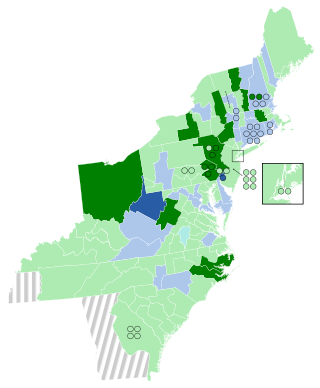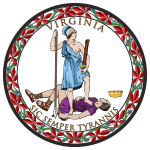
The 2000 United States House of Representatives elections were held on November 7, 2000, to elect U.S. Representatives to serve in the 107th United States Congress. They coincided with the election of George W. Bush as President of the United States. The Republican Party won 221 seats, while the Democratic Party won 212 and independents won two.

The 1938 United States House of Representatives elections was an election for the United States House of Representatives were elections for the United States House of Representatives to elect members to serve in the 76th United States Congress. They were held for the most part on November 8, 1938, while Maine held theirs on September 12. They occurred in the middle of President Franklin D. Roosevelt's second term. Roosevelt's Democratic Party lost a net of 72 seats to the Republican Party, who also picked up seats from minor Progressive and Farmer–Labor Parties.

The 1936 United States House of Representatives elections were elections for the United States House of Representatives to elect members to serve in the 75th United States Congress. They were held for the most part on November 3, 1936, while Maine held theirs on September 14. They coincided with President Franklin D. Roosevelt's landslide re-election. Roosevelt's Democratic Party gained twelve net seats from the Republican Party, bringing them above a three-fourths majority. This was the largest majority since Reconstruction, as the last time a party won so decisively was in 1866. As of 2023, this was the last time that any party held three-quarters of all House seats, as well as the last time that a party held more than 300 House seats.

The 1810–11 United States House of Representatives elections were held on various dates in various states between April 24, 1810 and August 2, 1811. Each state set its own date for its elections to the House of Representatives before the first session of the 12th United States Congress convened on November 4, 1811. They occurred during President James Madison's first term. Elections were held for all 142 seats, representing 17 states.

Virginia's 10th congressional district is a U.S. congressional district in the Commonwealth of Virginia. It is currently represented by Democrat Jennifer Wexton, who was first elected in 2018.

Robert Lincoln Ramsay was an English-born American politician who served as a member of the United States House of Representatives for West Virginia's 1st congressional district from 1933 to 1939, 1941 to 1943, and 1949 to 1953.

The United States House of Representatives elections in California, 1938 was an election for California's delegation to the United States House of Representatives, which occurred as part of the general election of the House of Representatives on November 8, 1938. Republicans gained four districts. Franck R. Havenner, first elected to Congress as a Progressive, was elected for the rest of his House career as a Democrat.

The 1994 United States House of Representatives elections in Virginia were held on November 8, 1994 to determine who will represent the Commonwealth of Virginia in the United States House of Representatives. Virginia has eleven seats in the House, apportioned according to the 1990 United States Census. Representatives are elected for two-year terms.

The 2000 United States House of Representatives elections in Virginia were held on November 7, 2000 to determine who will represent the Commonwealth of Virginia in the United States House of Representatives. Virginia has eleven seats in the House, apportioned according to the 1990 United States Census. Representatives are elected for two-year terms.

The 1932 United States House of Representatives elections in Virginia were held on November 8, 1932, to determine who will represent the Commonwealth of Virginia in the United States House of Representatives. Representatives are elected for two-year terms. Virginia had only nine seats in the House, losing a seat due to re-apportionment following the 1930 United States census. This election was unique because all representatives were elected at-large instead of the previously used electoral district system. However, this idea was not popular and the state returned to using electoral districts in the next election.

The 1938 United States elections were held on November 8, 1938, in the middle of Democratic President Franklin D. Roosevelt's second term. The Democratic Party lost 72 seats, mostly to the Republican Party, in the House of Representatives. The Democrats also lost eight seats to the Republicans in the U.S. Senate. Despite these heavy losses, the Democrats maintained control of Congress.

The 2004 United States House of Representatives elections in Virginia were held on November 2, 2004 to determine who will represent the Commonwealth of Virginia in the United States House of Representatives. Virginia has eleven seats in the House, apportioned according to the 2000 United States Census. Representatives are elected for two-year terms.

The 1998 United States House of Representatives elections in Virginia were held on November 3, 1998, to determine who will represent the Commonwealth of Virginia in the United States House of Representatives. Virginia has eleven seats in the House, apportioned according to the 1990 United States Census. Representatives are elected for two-year terms.

The 1986 United States House of Representatives elections in Virginia were held on November 4, 1986 to determine who will represent the Commonwealth of Virginia in the United States House of Representatives. Virginia had ten seats in the House, apportioned according to the 1980 United States Census. Representatives are elected for two-year terms.

The 1978 United States House of Representatives elections in Virginia were held on November 7, 1978 to determine who will represent the Commonwealth of Virginia in the United States House of Representatives. Virginia had ten seats in the House, apportioned according to the 1970 United States Census. Representatives are elected for two-year terms.

The 1966 United States House of Representatives elections in Virginia were held on November 8, 1966 to determine who will represent the Commonwealth of Virginia in the United States House of Representatives. Virginia had ten seats in the House, apportioned according to the 1960 United States Census. Representatives are elected for two-year terms.

The 1960 United States House of Representatives elections in Virginia were held on November 8, 1960 to determine who will represent the Commonwealth of Virginia in the United States House of Representatives. Virginia had ten seats in the House, apportioned according to the 1950 United States Census. Representatives are elected for two-year terms.

The 1940 United States House of Representatives elections in Virginia were held on November 5, 1940 to determine who will represent the Commonwealth of Virginia in the United States House of Representatives. Virginia had nine seats in the House, apportioned according to the 1930 United States Census. Representatives are elected for two-year terms.

The 1934 United States House of Representatives elections in Virginia were held on November 6, 1934 to determine who will represent the Commonwealth of Virginia in the United States House of Representatives. Virginia had nine seats in the House, apportioned according to the 1930 United States Census. Representatives are elected for two-year terms. This election was notable for the state's return to electoral district voting after briefly experimenting with electing all Representatives at-large in the previous election.









